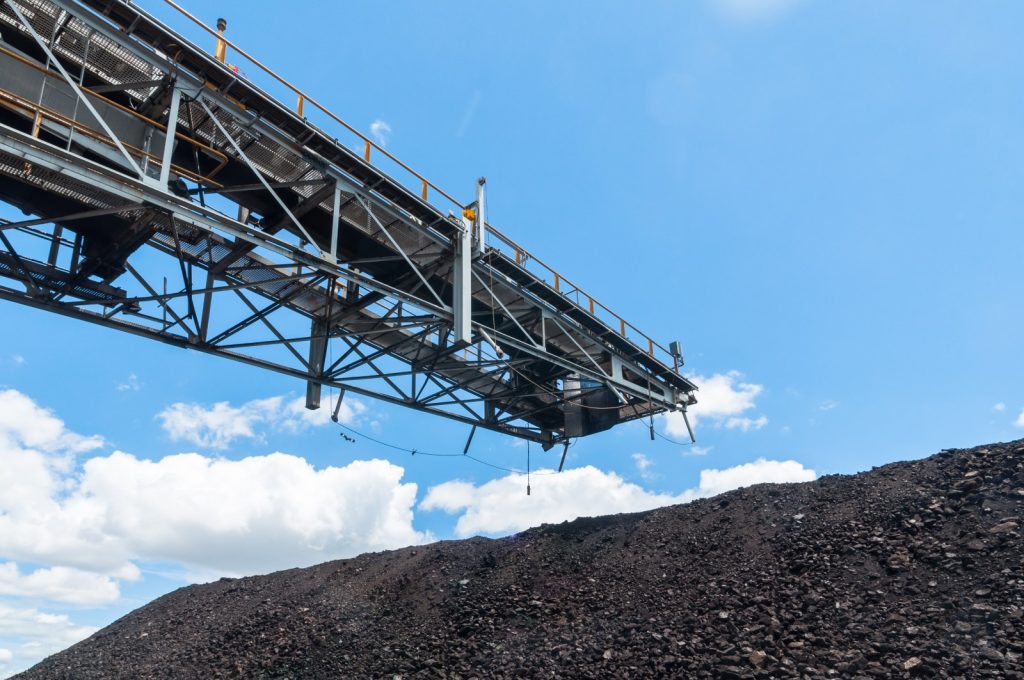What’s the Cost of a Stacker Conveyor?

Stacker conveyors play a crucial role in streamlining bulk material handling processes across a wide range of industries. However, understanding the cost of a new stacker conveyor can be complex, given the myriad of factors that go into their design and manufacturing.
Read on to learn more as we dissect the many elements that contribute to the cost of a stacker conveyor. From fundamental structural components to customizations tailored to your unique operational needs, our comprehensive guide will allow you to make a more informed buying decision.
TRADITIONAL STACKER CONVEYOR VS. RADIAL STACKER CONVEYOR
Before we delve into the cost, it’s crucial to understand the key differences between a traditional stacker conveyor and a radial stacker conveyor. The primary distinction lies in the undercarriage.
In a traditional stacker, you have fixed A-frame supports at 20ft. centers. In contrast, a radial undercarriage allows the tail section of the stacker to pivot back and forth at 135 degrees, offering flexibility and mobility.
ELEMENTS OF A TRADITIONAL STACKER CONVEYOR
Every traditional stacker conveyor comprises core components that ensure its reliable and efficient operation. There are also optional elements that can provide enhanced functionality based on specific user needs.
Let’s delve deeper into these elements to understand their roles:
CORE COMPONENTS
Fabricated truss—As the conveyor’s backbone, the fabricated truss is the principal structural component supporting both the conveyor and the load it carries. At West River Conveyors, we engineer our trusses to withstand various loads—including those induced by snow and wind— to ensure a sturdy and durable stacker conveyor.
Frame mounted idlers—These are critical for supporting the conveyor belt, maintaining its alignment, and ensuring the smooth transportation of materials.
Conveyor belt—The conveyor belt forms the moving platform for the material to be transported. The exact specifications of the belt are dictated by the type and properties of the material being stockpiled.
Head section—Located at the discharge point, the head section is where the material is unloaded from the conveyor.
Drive unit—This component, mounted at the head and connected to the discharge pulley, provides the necessary power for the conveyor’s operation.
Tail section—The tail section serves as the loading point for the material on the conveyor belt.
Skirting—Skirting is provided at the tail section and beneath the truss, offering protection against any material that might fall from the conveyor.
FACTORS INFLUENCING THE COST OF A STACKER CONVEYOR
Multiple factors affect the cost of a stacker conveyor:
Belt—The belt’s width, thickness, and type directly influence the price. A smaller belt (like a 24″ vs. a 54″) would be cheaper due to less material involved, and thicker belts are pricier due to their enhanced durability. Specific operations might also require special belt specifications such as fire resistance for underground use, which can increase the cost.
Length—A longer conveyor belt will inevitably cost more.
Tons/hour—The amount of material moved each hour is also factor in the cost of a conveyor. Larger volumes might necessitate a wider belt, which would increase the cost.
Speed—A faster-moving conveyor requires more horsepower and increases the price. A slow start-up might need additional components for a gentle ramp-up speed, resulting in more upfront costs but less wear and tear down the line.
Mobility—The choice between a mobile stacker (on wheels) and a fixed stacker also affects the cost.
Components and accessories—Customer-specific preferences regarding brands and parts can significantly vary the cost. At West River Conveyors, we maintain good relationships with certain brands, allowing us to offer great deals to our customers.
However, if a customer has loyalty to another brand, we are capable and willing to accommodate their preferences, even though this might increase the cost.
EVALUATING THE COST AND OPTIONS FOR STACKER CONVEYORS
Understanding the interplay of the various elements that contribute to the design and cost of a stacker conveyor is crucial. From the conveyor belt to the fabricated truss, let’s explore how these considerations affect your stacker conveyor’s design and, ultimately, its price.
Conveyor Belts—The maximum throughput (TPH) of your stacker conveyor, coupled with various material properties, will determine your conveyor belt’s width and speed. The significant properties include:
- Material weight and density
- Sharpness, granularity, and cohesion of the material
- Moisture and dust levels
- Belt troughing for efficient transport of varying material weights
- Conveyor belts can range between 24-60 inches in width, and their construction (steel-belted or multi-ply) depends on the load capacity required
At West River Conveyors, we estimate that the conveyor belt contributes directly to 3-5% of the total cost of your stacker, impacting numerous other machine specifications as well.
Conveyor Structure—The fabricated framework that supports the conveyor system, including its associated drive, reducer, and idlers, is a critical factor.
The structure’s dimensions depend on the elevation required by the radial stacker, taking into account the maximum gradient up which a particular aggregate can be efficiently transported.
Conveyor structures can span 30-150 feet or more, achieving discharge heights of up to 40 feet with elevation grades of 18-20°.
Fabricated Truss—Truss construction is necessary for larger conveyor structures, while smaller units might use 10×25 channel support structures. It’s crucial to note that truss-built structures can cost about 20% more overall than channel-supported conveyors.
Regardless of the construction method, the structure must support the equipment’s total weight, the maximum rated load, and additional temporary loads from snow or wind.
At West River Conveyors, we build equipment from various materials based on load requirements, costs, and operating environments such as mild steel, galvanized steel, stainless steel, and even aluminum for lightweight applications.
Radial Undercarriage—The radial undercarriage, which allows the conveyor to rotate and discharge material along an arc, accounts for roughly 15% of your unit’s cost. However, larger conveyors with dedicated hydraulic rise systems can add an additional 5-10% to the unit’s price.
Drive Unit and Reducer—The capacity and elevation of your conveyor system influence the minimum size of the required drive unit and reducer. Typically mounted at the discharge head and attached to the discharge pulley, drive units must lift the conveyor’s maximum rated loading weight from a standing start. These components will account for 7-10% of the total conveyor cost.
Additional Components—Other essential components contributing to the unit’s cost include:
- Frame-mounted idlers supporting the belt (around 7% of the unit cost)
- Head section, including discharge pulley, take-up screw, and additional idlers (5-10% of the total cost)
- The tail section, comprising hoppers and other loading and safety equipment (5-10% of the conveyor’s price)
- Catwalks for accessing the conveyor belts on larger units
- Additional cleaners and skirting on the conveyor belt for dust control and worker safety
Mobile Stacker Conveyors—For those requiring mobility, lightweight stackers can be provided in a “street-ready” trailer format, towable to the site by a large truck or semi. These units, equipped with specialized folding mechanisms, brakes, and lighting are typically more expensive than similar-sized fixed conveyors.
Hopper—Some stacker conveyor systems incorporate a hopper mounted over the tail, which holds the material before loading it onto the belt. Depending on the user’s requirements, the system can be engineered to load directly from an overland conveyor, belt feeder, transfer chute, or a Bobcat.
Catwalk—For added convenience and safety during operation and maintenance, we can install a catwalk on one or both sides of the truss. West River Conveyors can customize any stacker conveyor to meet very specific operational requirements.
WHY CHOOSE WEST RIVER CONVEYORS?
Choosing West River Conveyors means partnering with a company that values quality, innovation, and customer satisfaction. We firmly believe that anything is possible when you build customized products.
By focusing on your specific needs, we strive to provide the most cost-effective and efficient conveyor solutions. Trust us to make your material handling processes smooth and reliable.
Click below to learn more about the many available options for our customized stacker conveyors.

